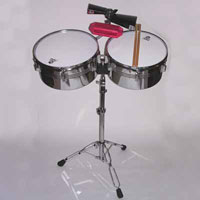
: : : Percussions : : Cuba : Instruments
The timbales

The Cuban timbales constitute a derivative of the classic European symphony orchestra timpani ("timbales" in French), which were also used, originally, in Cuba. The timpani are these semi-spherical copper drums played by mallets and originate from Mongolia. They placed one "timpano" (called "nakara") on each side of a camel, at the time of the conquests of Genghis Khan, and they were used to signal ambushes and retreats of the cavalry.
The concept of pair of timpani remained, but some virtuosos like Tito Puente ("El Rei" of mambo), played or play on a set of five timbales of different sizes (diameters from 12'' to 16 " ). There exists even what it is called mini-timbales or "timbalitos", from 6 to 10'' diameter. The principle of the single drum skin remained, but the latin timbales are now all with cylindrical shells, often painted or chrome steel or aluminum or even copper (more rich, powerful and typical sound), and even wood. This is what makes them original instruments. The hoop also changed to be closer to snare hoops, but is sometimes thinner and is equipped with only six tension bolts in general. So, the latin timbales are roughly similar to snare drum which might have the skin from below (resonance skin) removed with its hoop, and tension rods. The shell is generally deep, which allows to exploit a specific timbal technique: the playing against the shell, which gives a dry and high pitched sound (a bit like a guiro).
The timbales player generally uses a cowbell ("campana" in Spanish) with elongated shape that can be called "timbale bell", which is mounted on a metal rod positioned in the center, between the two drums. It can have several bells and also wood blocks placed on the same stem, in row, and also often a versatile cymbal, especially in salsa ("crash-ride" cymbal, large and thin) to replace the sound of jazz drummer (salsa is sometimes inspired from "Cubop", the original Latin jazz invented by Dizzy Gillespie, which included a jazz (modern) drummer and a conguero).

The timbales player plays standing, and to do this, the two timbales are raised by a single stand, per pair of timbales.
The Cuban timbales sticks are also original. They were probably designed by deriving and simplifying the shape of snare drum sticks. They are thinner and without ball shaped tips ("olives" in French), and therefore with a shape of a wooden cylinder with rounded ends, making them more handy for single stroke rolls and playing on skin and cowbell at the same time.
In accompaniment of the "mambo" or "rumba", we usually play the rhythm of "cascara" against the shell (with an horizontal hit) and for the "cha-cha", the "montuno" or "Nanigo" we use the central bell (also called "Timbale Bell" or " Cha-cha Bell "), with a vertical stroke.
The cascara (which means "shell" in Spanish, to name the resonance box of the drum, as in U.S.) is probably the oldest and the most typically Cuban rhythm with that of the clave (played notably in the "Santeria", Afro-Christian syncretic Cuban cult), both of them probably having an African origin (Mandingo for cascara, because it is found note for note the same in the polyrhythm "Djagbe" (see "A Life for the Djembe" by Mamady Keita ), and the clave is practiced in Benin; knowing that they develop in a complex structure in 16 beats, there is few chance that those exact matches are due to random (1 chance out of 2 exponent 16 = 65536, according to the probability)). During the execution of the cascara with the right hand, the left hand can accompany the rhythm of the "clave" on a bell or a "wood-block" or play a "tumbao" on the timbales, which requires a excellent independence of hands.
In the solos, the timbales players generally use single strokes played in "rim-shot" (the skin and rim are struck simultaneously, like a "slap" with hand drum, the hoop making leverage effect to multiply the energy and noise level), which gives a more African sounding. But the classic close binary roll with rebounds (one rebound per each hand) is also often used, especially for introduction breaks (fills).
Some timbales players (like "Changuito" ) also use a bass drum with pedal, which they play occasionally, to play the rhythm of "tumbao" (the rhythm of the bass), for example, but standing (unlike the drummer) which involves standing on one leg.

In contrast, some drummers such as Horacio "El Negro" Hernandez (of Cuban origin), Akira Jimbo , Mike Portnoy (from "Dream Theater", a progressive metal rock band) or Vince Cherico (drummer of the "New World Spirit" of Ray Barretto ), to name a few, have included timbales in their drum set, presumably to give a Latin "color". "Changuito" (Jose Luis Quintana, the inventor of the style "Songo") is one of the Cuban timbales virtuoso and educators today's most recognized and he made several reference instructional videos.
Typical developments of timbales practice (orchestrated for modern drumset), are presented in my drumset methods, notably with the cascara.
Marc De Douvan, November 2005, translation in English: May 2013.
© 2005 Marc de Douvan Crédits Mentions légales
